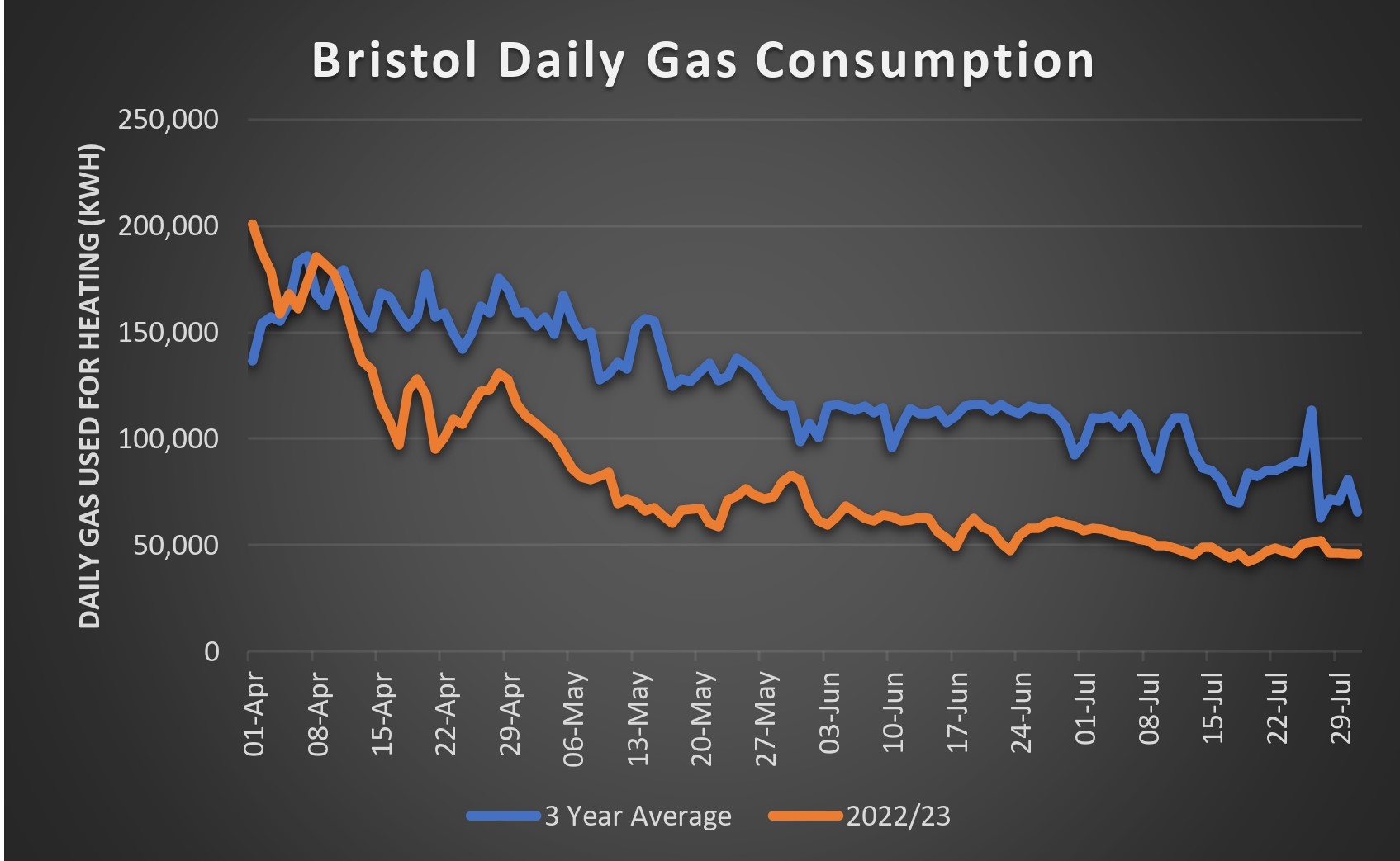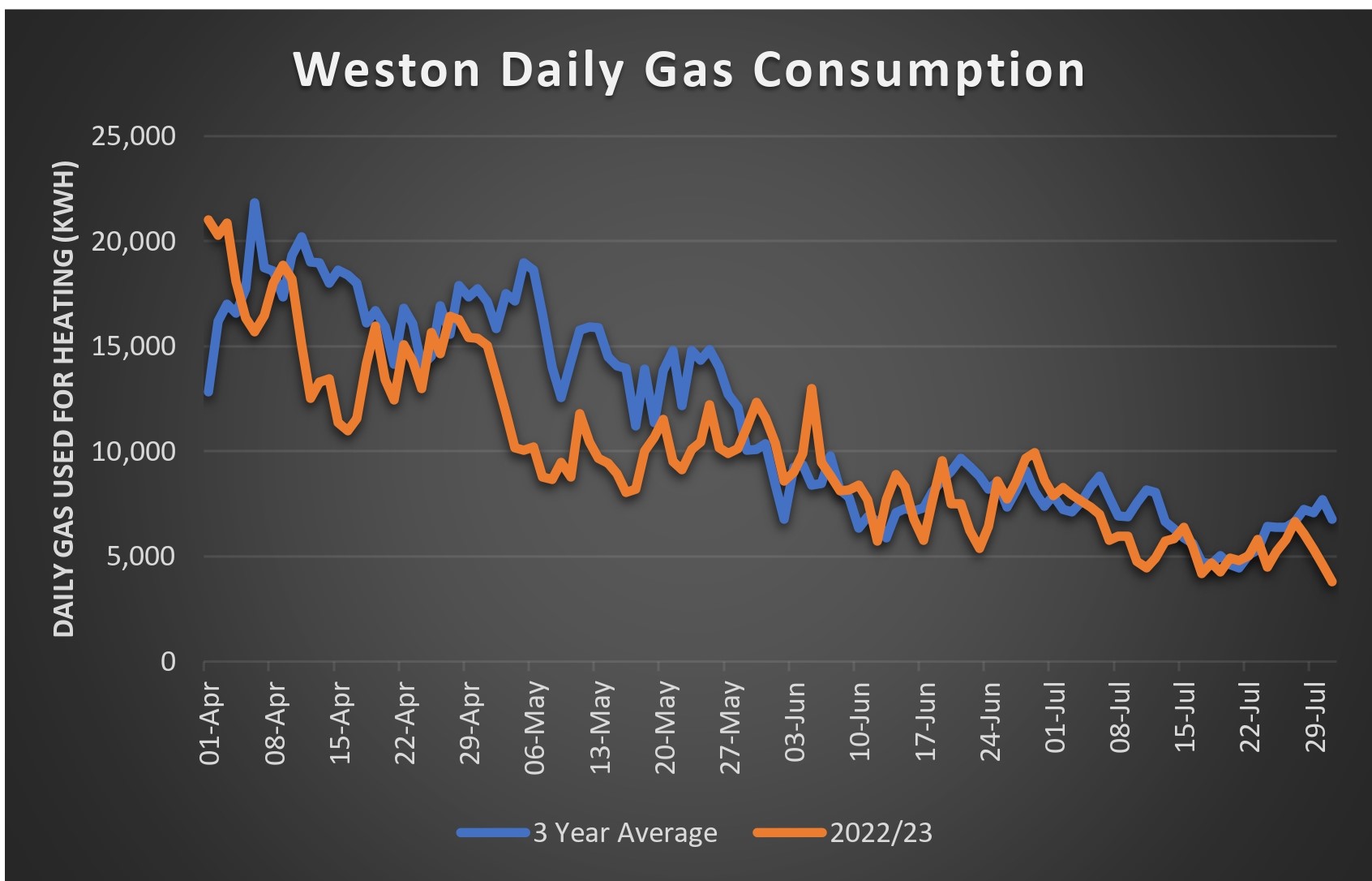Introduction
University Hospitals Bristol and Weston NHS Foundation Trust (UHBW) has a workforce of over 13,000 staff and delivers over 100 different clinical services across 10 different sites, serving a core population of more than 500,000 people. The trust has two main campuses in Bristol city centre and in Uphill, Weston-Super-Mare. The Trust declared a climate emergency in October 2019, partnering with Bristol City Council and their ambitious targets for carbon neutrality by 2030.
A major issue for UHBW in achieving carbon neutrality by 2030 is its gas emissions, used almost entirely for its large site heating and hot water demands. Up until April 2022, average annual gas consumption for heating across the Trust was 55GWh, with around 11% of this demand from the Weston General hospital. In 2020, the Trust embarked on the first phase of its vision to de-steam the Bristol estate with the installation of a heat network to supply four hospital buildings and install a combined heat and power engine (CHP) as a mechanism to fund the works. The completion of this de-steaming project was seen as a critical next step to achieving carbon neutrality as illustrated in the Trust’s initial road map.


Project detail
In November of 2020, UHBW made a successful bid to the Public Sector Decarbonisation Scheme (PSDS) and were awarded £17m for a range of works centred on their heat decarbonisation road map. The bulk of the funding was to go towards converting the remaining steam district heating on the southern half of the site to a low temperature hot water (LTHW) system to match the existing four buildings completed within phase 1 of the project. The remaining steam boilers would be replaced with duel-fuel gas boilers for LTHW. Among other efficiency measures, Weston General Hospital also received funding to resolve the existing efficiency issues in its current heating system.
Bristol works
The Bristol Royal Infirmary (BRI) site was historically heated via steam generated in the main energy centre via three steam boilers. Following phase 1 of the project to de-steam the site, one of these steam boilers was replaced with a 5.86MW combination boiler, capable of being converted to LTHW in phase 2 of the scheme. Following phase 1, exhaust heat from the newly installed 3.36MW CHP was used as a pre-heat to generate steam for the site. The four hospital buildings that had been converted to LTHW were supplied directly by the LTHW heat generated by the CHP but retained the ability to switch back to steam in the event of a CHP fault.
The second phase of the scheme, funded via the PSDS grant, replaced the remaining steam boilers with 2x 6.8MW duel-fuel LTHW boilers and installed district heating pipework to the remaining 6 sites, including some smaller buildings with their own independent gas boiler heating systems. Within the scope of this scheme was also the replacement of all pumps installed on the primary network with high efficiency variable speed drive integrated equivalents, upgraded building controls and heat metering. In all, 4,939 metres of pipework was installed across the Bristol estate to complete the heat network, at a cost of £14.4 million.
Weston works
Weston General Hospital comprises of a main hospital building with smaller external buildings delivering clinical care and admin/training space. Where the main hospital building has already undergone the process of de-steaming, funding was focused on improving efficiency across the site and to connect external buildings to the existing LTHW system to utilise a higher proportion of the available CHP heat.
The current set up at the hospital comprises of a main 0.55MW CHP and 4x 0.55MW boilers providing hot water for DHW and LTHW across the main hospital. This is split into 4 circuits within the boiler room:
- Domestic hot water supplying heat plate exchangers at both ends of the hospital;
- LTHW circuit to a small private ward on the premises;
- LTHW circuit to estates and facilities and several other smaller support offices;
- A main LTHW header in the roof space providing heating for Constant Temperature (CT) and Variable Temperature (VT) systems across the main hospital.
Existing flow testing and low differential temperature (dT) flow and returns have highlighted on many occasions that there are existing issues with hydraulic separation between the various secondary circuits in the roof space, owing to heat losses and poor heat utilisation from the CHP and boilers during the early and latter stages of winter and fringe months. £650,000 of funding was granted to rectify these existing issues, as well as replacing existing fixed speed pumps to re-balance the system and improve the heating control strategy around the hospital. In addition to this, the new heating has been designed to incorporate new secondary circuits to supply LTHW to the external buildings, thereby removing additional gas assets and utilising additional CHP heat when available.
Challenges in delivery
The works in Bristol commenced in early 2021 with the successful contractor deployed onto the site around May 2021. In Weston, works commenced in October 2021 following initial design works and tender process. Although construction of both projects was completed by the PSDS deadline of April 2022, neither scheme was without their challenges.
Removing the steam supply resulted in the need to maintain hospital services that use steam. The chief consideration on this project is the Central Sterile Services Department or CSSD, which operates near 24/7 critical sterilisation services for the Trust. The initial design to electrify CSSD used electrode boilers to generate steam, but we realised we could pre-heat the feed water intake of the washers via the new LTHW district heating and generate steam within the washers themselves, removing the need for external steam boilers. There is a significant power draw to electrify the steam generation, requiring a new 1.7MVA transformer to supply the building, but the LTHW system should be able to provide about 63KW of pre-heat.
In addition, some of the smaller external buildings were not feasible to connect onto the newly expanded district heating network. For these, additional funding was secured to convert the supplies to standalone air-source heat pumps. By doing this, these systems alone achieved around 6.97 tonnes of CO2e in its first year of operation and permanently removed the gas supplies from the buildings.
The district heating network in Bristol was required to run down through the main ambulance access route to supply heating to the lower half of the estate. To allow the road to be excavated for the pipework to be installed, the main access route to the sites A&E department was moved for a period of 4 weeks. This caused significant disruption to the site and delayed the project significantly to allow proper planning as to not impact on patient care. Likewise in Weston, the tight timescales required modifications to the existing heating system during the winter heating season. Careful planning had to be undertaken across 15 heating shutdowns to ensure that our patients, staff and visitors remained comfortable throughout.
Throughout this period there were also significant delays in lead times of equipment, particularly impacting the delivery of key components like pumps and building management system controllers. These elongated certain elements of the programme risking grant funding availability in the event that the projects over-ran past the PSDS deadline.
Project outcome
The initial aim of both projects was to improve the efficiency of the heating systems at Bristol and Weston and improve the system controls to expand the options for further decarbonisation in the future. The projects were both particularly successful in delivering these aims as well as achieving a significant reduction in gas usage.

In Bristol, the result of de-steaming the site has been a degree-day adjusted reduction in like-for-like gas used for heating of 28.7% against 3-year average (April-July 2022 data), with an estimated annual saving of 7,881MWh gas. There has been a small increase in associated electricity consumption due to the electrification of CSSD steam supply, however overall, this represents a CO2e saving of 1,413 tonnes annually.

In Weston, the results have also been encouraging, with a 9.2% reduction in gas used for heating against 3-year average (April-July 2022 data), with an estimated annual saving of 462MWh gas. Due to the replacement pumps and improvement in control strategy, Weston also saw an annual electricity saving of 404MWh, equating to an overall CO2e reduction of 188 tonnes.
Challenges for continuing heat decarbonisation
Now that the distribution systems have been successfully prepared for both sites to switch the heat source from CHP to a lower/net zero carbon alternative, the next stage will be to reduce the temperatures of the network. Currently options are being explored of how this will be achieved, but in its simplest form it will involve reducing the heat demand of the buildings and lowering building-side temperatures.
The current plan is to survey each building to identify the most cost effective schemes to reduce energy consumption. This will include projects like double/triple glazing, insulation, changes to building fabric, or other ‘deep-retro fit’ measures.
Another looming challenge will be the increasing demands for electrification from the heat pumps and other sustainability initiatives such as electric vehicle charging. Both Bristol and Weston have very little spare capacity, so an ‘Increasing Electrification Working Group’ was established to gather key stakeholders around the Trust to forecast future electricity demand and begin making bids for infrastructure capital to start upgrading the capacity now, in preparation for the expected increasing demands.
More information and case studies on the decarbonisation topic can be found in the EMA Guide to Net Zero.

